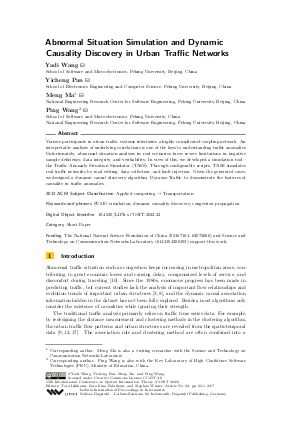Abnormal Situation Simulation and Dynamic Causality Discovery in Urban Traffic Networks (Short Paper)
Authors Yadi Wang, Yicheng Pan, Meng Ma, Ping Wang
-
Part of:
Volume:
15th International Conference on Spatial Information Theory (COSIT 2022)
Part of: Series: Leibniz International Proceedings in Informatics (LIPIcs)
Part of: Conference: Conference on Spatial Information Theory (COSIT) - License:
 Creative Commons Attribution 4.0 International license
Creative Commons Attribution 4.0 International license
- Publication Date: 2022-08-22
File

PDF
LIPIcs.COSIT.2022.22.pdf
- Filesize: 6.08 MB
- 7 pages
Document Identifiers
Subject Classification
ACM Subject Classification
- Applied computing → Transportation
Keywords
- SUMO simulation
- dynamic causality discovery
- congestion propagation
Metrics
- Access Statistics
-
Total Accesses (updated on a weekly basis)
0PDF Downloads0Metadata Views
Abstract
Various participants in urban traffic systems intertwine a highly complicated coupling network. An interpretable analysis of underlying correlations is one of the keys to understanding traffic anomalies. Unfortunately, abnormal situation analysis in real scenarios faces severe limitations in negative sample deficiency, data integrity, and verifiability. In view of this, we developed a simulation tool - the Traffic Anomaly Situation Simulator (TASS). Through configurable scripts, TASS simulates real traffic networks by road editing, data collection, and fault injection. Given the generated cases, we designed a dynamic causal discovery algorithm, Dycause-Traffic, to demonstrate the features of causality in traffic anomalies.
Cite As Get BibTex
Yadi Wang, Yicheng Pan, Meng Ma, and Ping Wang. Abnormal Situation Simulation and Dynamic Causality Discovery in Urban Traffic Networks (Short Paper). In 15th International Conference on Spatial Information Theory (COSIT 2022). Leibniz International Proceedings in Informatics (LIPIcs), Volume 240, pp. 22:1-22:7, Schloss Dagstuhl – Leibniz-Zentrum für Informatik (2022)
https://doi.org/10.4230/LIPIcs.COSIT.2022.22
BibTex
@InProceedings{wang_et_al:LIPIcs.COSIT.2022.22,
author = {Wang, Yadi and Pan, Yicheng and Ma, Meng and Wang, Ping},
title = {{Abnormal Situation Simulation and Dynamic Causality Discovery in Urban Traffic Networks}},
booktitle = {15th International Conference on Spatial Information Theory (COSIT 2022)},
pages = {22:1--22:7},
series = {Leibniz International Proceedings in Informatics (LIPIcs)},
ISBN = {978-3-95977-257-0},
ISSN = {1868-8969},
year = {2022},
volume = {240},
editor = {Ishikawa, Toru and Fabrikant, Sara Irina and Winter, Stephan},
publisher = {Schloss Dagstuhl -- Leibniz-Zentrum f{\"u}r Informatik},
address = {Dagstuhl, Germany},
URL = {https://drops.dagstuhl.de/entities/document/10.4230/LIPIcs.COSIT.2022.22},
URN = {urn:nbn:de:0030-drops-169077},
doi = {10.4230/LIPIcs.COSIT.2022.22},
annote = {Keywords: SUMO simulation, dynamic causality discovery, congestion propagation}
}
Author Details
- School of Electronics Engineering and Computer Science, Peking University, Beijing, China
- National Engineering Research Center for Software Engineering, Peking University, Beijing, China
Funding
The National Natural Science Foundation of China (92167104, 62072006) and Science and Technology on Communication Networks Laboratory (6142104200103) support this work.
References
-
Michael Behrisch et al. Sumo-simulation of urban mobility: an overview. In Proceedings of SIMUL 2011, The Third International Conference on Advances in System Simulation. ThinkMind, 2011.

-
Gleb Beliakov et al. Measuring traffic congestion: an approach based on learning weighted inequality, spread and aggregation indices from comparison data. Applied Soft Computing, 67:910-919, 2018.

-
Etienne Come et al. Spatio-temporal analysis of dynamic origin-destination data using latent dirichlet allocation: Application to vélib'bike sharing system of paris. In TRB 93rd Annual meeting, page 19p. Transportation Research Board, 2014.

-
Clive WJ Granger. Investigating causal relations by econometric models and cross-spectral methods. Econometrica: journal of the Econometric Society, pages 424-438, 1969.

-
Meng Hu et al. A copula approach to assessing granger causality. NeuroImage, 100:125-134, 2014.

-
Bin Jiang et al. Topological analysis of urban street networks. Environment and Planning B: Planning and design, 31(1):151-162, 2004.

-
Zihan Kan et al. Traffic congestion analysis at the turn level using taxis' gps trajectory data. Computers, Environment and Urban Systems, 74:229-243, 2019.

-
Felix Kling et al. When a city tells a story: urban topic analysis. In Proceedings of the 20th international conference on advances in geographic information systems, pages 482-485, 2012.

-
Xi Liu et al. Revealing travel patterns and city structure with taxi trip data. Journal of transport Geography, 43:78-90, 2015.

-
Qiong Lu et al. The impact of autonomous vehicles on urban traffic network capacity: an experimental analysis by microscopic traffic simulation. Transp. Lett., 12(8):540-549, 2020.

-
Daniel Malinsky et al. Causal structure learning from multivariate time series in settings with unmeasured confounding. In Proceedings of 2018 ACM SIGKDD workshop on causal discovery, pages 23-47. PMLR, 2018.

-
Feng Mao et al. Mining spatiotemporal patterns of urban dwellers from taxi trajectory data. Frontiers of Earth Science, 10(2):205-221, 2016.

-
Meike Nauta et al. Causal discovery with attention-based convolutional neural networks. Machine Learning and Knowledge Extraction, 1(1):312-340, 2019.

-
Angeliki Papana et al. Detecting causality in non-stationary time series using partial symbolic transfer entropy: Evidence in financial data. Computational economics, 47(3):341-365, 2016.

-
Felix Rempe et al. Spatio-temporal congestion patterns in urban traffic networks. Transportation Research Procedia, 15:513-524, 2016.

-
Jakob Runge et al. Detecting and quantifying causal associations in large nonlinear time series datasets. Science advances, 5(11):4996, 2019.

-
Xiaoying Shi et al. Exploring the evolutionary patterns of urban activity areas based on origin-destination data. IEEE Access, 7:20416-20431, 2019.

-
Huijun Sun et al. Urban traffic congestion spreading in small world networks. International Journal of Modern Physics B, 19(28):4239-4246, 2005.

-
Zhang Zhang et al. A general deep learning framework for network reconstruction and dynamics learning. Applied Network Science, 4(1):1-17, 2019.

